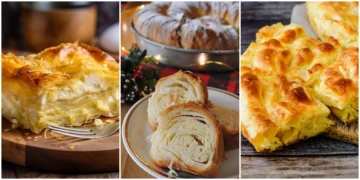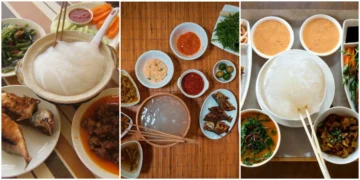Croatia, known for its stunning Adriatic Sea coastline, rolling hills, historic cities, and storied cultural history, also offers an equally varied culinary landscape. Of its many celebrated dishes, Peka stands out as the best food of Croatia. Derived from the Croatian word meaning to roast under a bell, Peka is not simply a dish but an inimitable culinary ritual, celebrating centuries-old coastal and rural traditions that define Croatian cuisine.
Why Peka Is the Best Food of Croatia?

Peka has earned its place among Croatia’s finest culinary expressions thanks to its signature combination of flavors and communal spirit. This dish typically involves slow-cooking meat (typically lamb or veal, with other seafood variations like an octopus for coastal variations) along with vegetables under a bell-shaped lid (the peka) covered by hot coals for optimal results: tender meat with perfectly integrated vegetables that boasts an unforgettable smokey flavor!
Peka’s beauty lies in its simplicity and the art of slow cooking, perfected over generations by experts who ensure natural flavors remain preserved while creating a delectable meal that nourishes body and soul alike. Enjoyed at family gatherings, festive celebrations, or communal outdoor feasts, Peka embodies Croatian values of tradition, resourcefulness, and togetherness – perfect for sharing on any social occasion.
Ingredients of Peka
- Meat or Seafood: Peka dishes vary by region, but typically consist of lamb, veal, goat meat or seafood. Meat selection depends upon its flavor and tenderness – which slow-cooking process greatly enhances.
- Vegetables: Potatoes, carrots, onions and bell peppers are popular vegetables to add into a dish. By absorbing aromatic flavors of the dish and their natural sweetness they also enhance its aromas and flavors.
- Aromatics and Herbs: Garlic, rosemary, and thyme can add depth to your dishes by elevating their flavors, while fresh herbs add fragrant touches that pair nicely with meats and vegetables.
- Olive Oil and Seasonings: When adding flavor to any dish, using high-quality olive oil combined with salt and pepper helps enhance and balance out its overall flavor profile. Sometimes incorporating local white wine can add depth and subtle acidity that adds depth and nuance.
- Peka Vessel: Although not technically an “ingredient,” the bell-shaped lid used in the peka method of cooking is essential. It creates an optimally heated environment and traps heat and smoke for uniform cooking of every ingredient.
Prepare Peka (Best Food of Croatia)

- Preparing Ingredients: The initial step involves gathering and prepping all the fresh ingredients needed. Meat or seafood should be cut into large chunks for even cooking, while vegetables must be chopped into sizeable chunks.
- Layering in a Peka Vessel: In the traditional preparation of this meal, ingredients are assembled in a shallow dish or pan and carefully layered in layers. Starting with meat at the base, followed by vegetables on top, aromatic ingredients like garlic or herbs scattered among layers, and drizzles of olive oil drizzled onto each component, along with sprinkles of salt and pepper for extra flavor enhancement.
- Covering and Sealing: Once assembled, each dish is covered with a heavy bell-shaped lid known as the peak. It creates an airtight seal around all ingredients within. This method traps steam, heat, and smoke which permeates throughout the cooking process. It gradually permeates each bite of food as time goes on.
- Slow Cooking with Coals: A vessel is placed into an earthen oven and hot coals are added on top of its lid. It creates a slow, even heat source to slow cook a dish for several hours–usually 2 to 3 hours. This method allows meat to become extremely tender while vegetables take in all of their aromatic flavors.
- Finishing and Serving: At the conclusion of cooking time, coals are carefully removed before the peka is unveiled. Each component is expertly cooked to produce an irresistibly flavorful dish filled with comforting yet exhilarating aromas reminiscent of its Eastern origins. Diners usually share Peka among family and friends in order to strengthen community ties while commemorating tradition.
What Makes Peka Unique?
Peka stands out as something special because of its preparation method and how well it encapsulates Croatian culinary traditions. Slow roasting under a sealed lid combined with smoke-infused aromatic herbs creates an incomparable flavor profile. Unlike conventional oven-roasted dishes, Peka ensures that each ingredient of its dish becomes an integral component. It creates a cohesive and deeply satisfying dish that leaves customers satisfied.
Peka is more than just about taste; it’s about experience. The communal aspect of preparing and sharing a Peka meal fosters a strong sense of unity and tradition. Generations have enjoyed its delicious offerings from Dalmatian hinterlands to festive celebrations along the Adriatic coast. Simply raising its lid transforms every meal into an event, celebrating the joys of sharing food.
History of Peka (Best Food of Croatia)

Peka is deeply interwoven into Croatia’s agricultural and pastoral traditions, emerging as a practical method for cooking large amounts of meat and vegetables using only local resources available in rural settings. Originating as ancient cooking techniques were utilized, making use of limited fuel supplies while giving communities ample sustenance during challenging seasons.
As Croatia grew and urbanized, the Peka method remained a symbol of traditional life and communal cooking. Now an integral part of family gatherings, festivals, and regional celebrations. From humble meal to celebrated culinary art form–just as in life.
Delicious Traditional Dishes of Croatia
- Pasticada: Pasticada is a slow-cooked beef dish marinated with red wine and herbs. It is served typically with gnocchi as part of Dalmatia’s famous culinary traditions. Cevapi: Grilled minced meat sausages served on flatbread with onions – another popular Balkans dish featuring simple yet bold flavors.
- Sarma: Cabbage rolls filled with meat and rice that reflect Central European influences in Istria’s cuisine, embodying its distinct flavors.
- Istrian Truffles: Delectable truffles that exude Istria’s authentic flavors are often featured as pasta garnish or gourmet condiment.










Discussion about this post